|
|
| |

Minerva, Roman goddess.
Alabaster, basalt, luna marble bust. 1st c BC. National Museum
of Rome, Museo Massimo. Rome.
Courtesy: VRoma
Highlights
* There were many gods in many places,
with more created all the time.
* Humans had a public relationship
with the gods, not a private, spiritual one.
* The purpose of Roman religion was to
gain benevolence from these powerful spirits, to ensure the
safety of the state and the family.
* The later Emperors thought they
themselves were gods, and built elaborate temples to show it.
Glossary
of Roman Religion
Web
Resources and Books |
|
Roman Religion: The Ancient Gods
In Rome, I took a
bus from the Colosseum to the Palazzo Massimo alle Terme, one of
the National Museums of Rome, located near the central train
station and the Baths of Diocletian. So simple to get there, not
so simple to get elsewhere afterwards-the City's transportation
hub centered on the train station is large and chaotic. The magnetic lure
of ancient Rome prevailed.
Inside the building, past the guard station, right in front of
me--a giant statue. Minerva, goddess. Glowing in color, not
chilled in snow.
Who was this creature? Minerva, goddess.
To the Greeks, Athena.
My next hunt was on.
Were there many gods? What
good were they? What did they
look like?
Could you
talk to a god? Could
a god help you out?
Harm your enemy?
What if you made a god
angry?
Why so many
priests?
What went on at
a sacrifice?
Where did Romans worship?
Could a
human become a Roman god?
|
|
|
|
|
|
|
|
|
|
|
|
|
The number of Roman
gods
The Romans worshipped an astonishing number of gods and
goddesses.
Gods here, goddesses there--there was no end of the way
they kept popping up in temples, groves of trees, babbling
brooks and springs, crossroads, caves, theaters, and urban baths.
A good place to see them is the Vatican Museum in Rome. It's
famous for far more than the Sistine Chapel. Off I went to
spend a day at the Vatican Museums. Here's what I saw, when I
wasn't crushed by the good-natured crowds. Everyone loves a god and goddess.
Some gods shared territory. Mars, Jupiter, Bellona and Victoria, even
Juno, and later Mithras were all worshipped in connection with
war.
Many had more than one assignment.
Juno had an especially large portfolio--goddess of war, of marriage, of new beginnings, of youthfulness
and liveliness, as protector of the community.
To the Roman way of thinking, a multi-purpose god was only
natural. Very different strands of life were part of a whole in their society.
There were "great" gods like Jupiter, Juno, and Minerva, and narrow-bore gods like Imporcitor, the god of "ploughing with
wide furrows."
Most did not have much personality or character.
|
|

Sightseers
throng to the galleries of
the Ancients. The Vatican Museums, Rome.
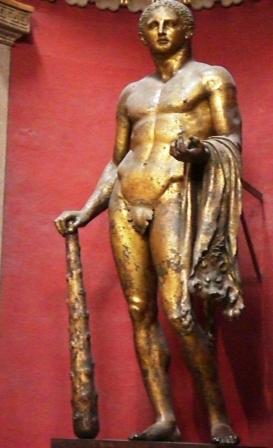
The Gigantic Hercules.
Bronze. Roman.
1st c
AD. Vatican Museums.
|
|
|
|
|
|
|
|
|
A surprise to me: more gods and their cults
needed to be created all the time.
To the Romans, this made perfect sense: in the ancient world, gods and
goddesses had active sex lives. Of course they produced god-children.
The process for becoming a recognized god was straightforward.
An
existing god told the humans it was time to do something, usually
through a sign like a major military victory.
Since a Roman could not worship a god unless the god was recognized by the state, the Senate
got busy and reviewed the
proposed new god.
Eventually, the Romans lost track of
their multiplying gods and goddesses.
In the 1st century BC, the
Roman writer Varro tackled the mess. Varro wrote the Wikipedia of its day
on the subject, his vast
Divine Antiquities.
|
|
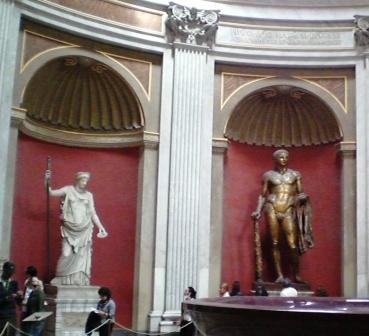
Visitors dwarfed by the gods
Juno
and Hercules. Vatican Museums, Rome.
|
|
|
|
|
|
|
|
|
|
|
|
|
Purpose of the gods?
Did the gods have nothing better to do than clutter up the lives
of the humans?
To the Romans, their gods were powerful
and somewhat unpredictable
forces outside of human society that could impact Rome's very existence.
The gods didn't provide an Adam-and-Eve creation story, nor promise
redemption like the Christ story, nor provide an code of ethics that
could make you a better person.
To the state, the gods could deal a victory in war; to
the community, a good harvest; to the family, a successful childbirth.
From these powerful gods, the fearful Romans sought "benevolence."
Why did a Roman need benevolence? Though the gods may not have
always been
capricious, the everyday world of a Roman appeared so. With an
expected lifespan of only 25 years, children died all around
you. Those who survived were malnourished. Illness and injury had few
effective treatments. Threats of invasion, burrowed deep in the Roman
collective memory, still seemed imminent.
The more
protection from a god, the better off you might be.
|
|
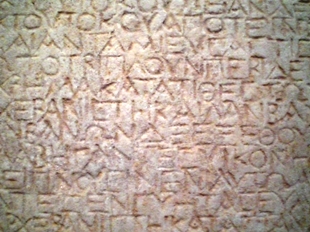
Rules for Worship of Hercules.
Marble. Roman. 2nd c AD. Getty Villa. (Partial). This marble
tablet shows the statutes of a religious association that worshipped
Hercules.
The text includes rules of conduct--you couldn't get rowdy and engage in
fighting during the meeting, and you must wear a wreath in honor of
Hercules.
The Romans were keenly interested in wealth and status.
The tablet
explained the association's endowment and how it would be spent. |
|
|
|
|
|
|
|
|
|
|
|
|
What did a Roman god look like?
Gods looked mostly like humans, preferably Roman humans with
maybe some
Greek or Etruscan influence.
Minerva, the goddess pictured at the top of this page, looks a lot like
a human woman. Though supersized-- and with a strikingly big foot-- she is dressed in
the clothing
fashion of the day.
A few ancient gods changed form, like the
Greek Zeus (the Roman Jupiter) who changed from a human-like god form
into a bull to lure away a young human woman known
as "Europa."
The god Mithras, though he was born from a stone, emerged as a
fully-formed human youth.
|
|
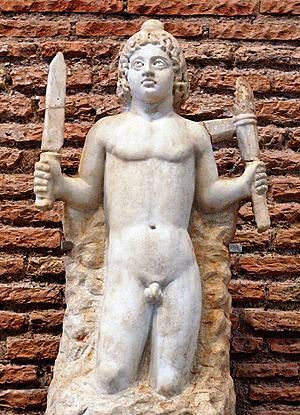
Mithras
born from a rock.
Marble, 180-192 AD. From the area of S.
Stefano Rotondo, Rome.
Courtesy:
Wikipedia Commons |
|
|
|
|
|
|
|
|
|
|
|
|
Talking to a Roman god
Talking to the gods was a difficult
business.
Everything in the ritual had to performed without the
slightest variation or error. The right mumbo-jumbo said just so
by the right person at the right time in the right place. The Romans must have had
an obsessive-compulsive gene in their blood.
Could a god help you out?
The gods may or may not help you out in a specific situation.
Adornments might assist. From the time
he was 9 days old until he was 16 years of age, Roman boys wore
a bulla on a chain around their necks. Nestled inside the bulla
were amulets to channel the energy of a divinity and
protect against evil forces.
|
|
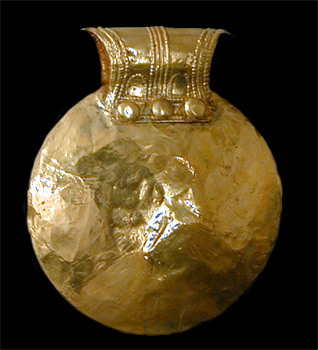
Bulla-amulet.
Roman, 1st C AD.
Gold. Palazzo Massimo, Rome.
Courtesy: VRoma.
|
|
|
|
|
Divine Friends with Benefits
Emperors chose a personal god and blatantly (for some,
desperately) advertised the
"special relationship." Domitian had Minerva, Augustus claimed
Apollo, Diocletian roped in Jupiter. Nero thought he WAS a god. The protection plan
evidently had limits: Domitian was assassinated and the memory
of him officially X'ed out.
A Roman might change gods if he felt he was under the wrong one.
Emperor Constantine initially chose the Sun god, Sol. At a
crucial point in his military campaign in Italy, he switched to
the Christian God. Constantine won. Christianity won. The other
gods lost--Christianity in the later Roman Empire tossed
out the old Roman religions and gods.
|
|
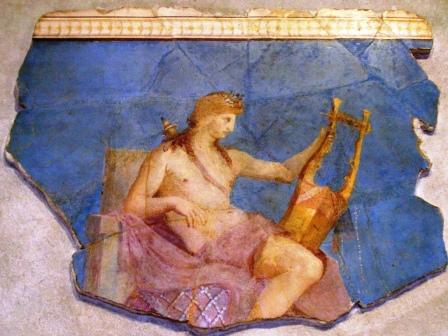
Apollo,
special divine friend of Emperor Augustus.
Fresco fragment from the
Palatine. Roman. Palatine Museum, Rome.
|
|
|
|
|
|
|
|
|
|
|
|
|
Could a god harm your enemy for you?
You could not demand a Roman god to allow you to harm someone
else. Harming someone else was "impietas"
The worst form of "impietas" was to
kill a member of one's family. Emperor Nero murdered his mother,
Agrippina. Born with a sign of luck-- a double canine tooth in her upper right
jaw--Agrippina was appointed a priestess of the cult of
her late, deified husband, the Emperor Claudius. Neither her
good-luck tooth nor her status as priestess protected her from her
murderous son.
Afterward Agrippina was murdered, Nero's friends noticed
he was tormented "by the gods." We might say by guilt.
|
|
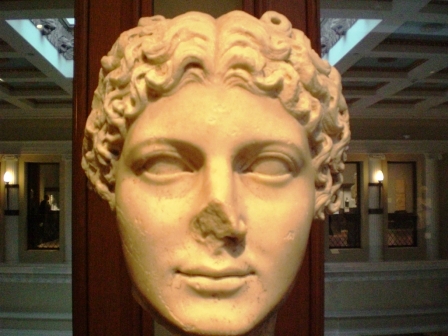
Agrippina
the Younger, mother of Emperor Nero.
Roman. Marble. Getty
Villa, Malibu.
In
Roman society you had a duty to respect another person, at least a
person of your own rank or better.
How you could treat those beneath you in status, or an enemy of the
state,
was a different matter.
|
|
|
|
|
|
|
|
|
What if you made the gods angry?
The gods were serious about "impietas."
A grave "impietas" was to knowingly violate a divine
rite. For this, the gods might avenge themselves upon Roman
society and state as a whole, not just upon the offending
individual.
Recall the legend of Publius Claudius, the Roman consul and general who went into
battle against the Carthaginians even though the signs from the gods clearly
said "halt": the sacred chickens had refused to eat properly!
The grains of cake did not fall from their mouths just so! Claudius, fed up, ordered
the chickies thrown into the sea, declaring: "If they will not eat, let
them drink."
The Romans weren't merely defeated, they were routed. And Publius Claudius? He was tried in Rome for
"impietas." Fined and
sent into exile (i.e., tossed out of the community and without his wealth,) he committed suicide. |
|
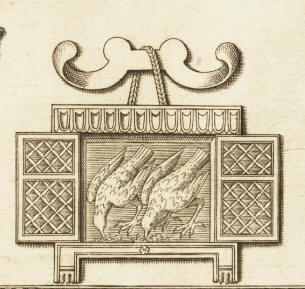
Sacred Chickens in their Cage.
Photo of a marble table, Roman.
Source: University of Chicago Libaries,
Speculum Magazine.
In Latin, the cage is called a "Pullaria
cavea." A "pullarius" was the bird-handler. His duties were
to open the cage and feed the sacred chickens in a particular manner.
|
|
|
|
|
|
|
|
|
|
|
|
|
Why were there so many priests?
And priestesses and Vestal Virgins!
The gods
ruled the fate of the state and therefore the Roman state had to regulate
itself according to religion. The Romans needed to know the "will of the gods"
before embarking on any human enterprise, large or small.
Passing laws, holding elections, and discussing public policy
took place within spaces defined by priests. The Senate could
meet in one of several places, but not just any old place: one
that had been defined by the priests as not offensive to the gods.
To start any Senate meeting-- or start a war-- a Senator-priest
had to invoke the proper religious ritual.
A religion this pervasive would of course require lots of
priests!
A priest was expected to come from the political-military-social
elite that governed Rome. For an elite Roman male, the priesthood was not
his sole occupation; it was part of his normal life.
Priesthoods were organized into colleges, each with their own
sphere of influence. There was no "chief priest."
Places in the
priesthoods followed the gradations of the elite's social hierarchy.
In the later Empire, the most important priesthoods were
attached to the Imperial cult, worshipping the ruling Emperor
and his family as divine.
But priests had to be careful what they forecast: even an
Etruscan haruspex did not lightly prophesy the demise of a
Roman Emperor.
|
|

Coin
struck by Caesar c 45 BC, showing himself as
Pontifex Maximus.
Quick
Glance at Priests and Prophets:
For more detail see the
glossary on Roman religion below.
The major priestly groups:
Augurs: "took the auspices" or discerned the will
of the gods, when an important event, such as a military battle, loomed.
Duoviri, decemviri, and quindecimiviri: advised the
Senate on reports of prodigies.
Flamines: Individual priests
for the early gods, Jupiter, Mars, and Quirinus.
Pontifices: controlled the calendar and kept the record of
public events.
Ordinary priests: Their role was to
show up and be seen as representatives of the political and military
elite.
Haruspex: An Etruscan highly specialized in the art of
prophecy. A Haruspex knew a mountain of technical mumbo-jumbo. |
|
|
|
|
|
|
|
|
|
|
|
|
What went on at a sacrifice?
In Rome, I went to see visuals about
Roman religious sacrifice at the Capitoline Museum and at the
Curia in the Roman Forum. This lovely Roman marble fragment pictured
right is at the
Capitoline. What I remember is the bull. How cooperative he seems! The
sheer calmness of the beast looms over the ferocity of the humans. As a
child growing up, I recall our cow Josie was not at all gentle. Perhaps
Josie knew where she was going to end up, and this bull doesn't.
A sacrifice in Roman religion offered up an animal, not a human. Bulls,
cows, sheep, and pigs seem to calmly take their
place in the ritual.
The animals must be one of two colors,
black or white. Cattle, and only oxen at that, are offered to
Jupiter. Mars gets a bull, and Vulcan a calf.
Female animals should be
offered to female deities, and male animals to male gods.
The ceremony of the sacrifice reflects the Roman social order. The
magistrate-augur is in charge of the ceremony, since he is responsible for
mediating the contact with the god. Here's what happened:
At the Temple of Jupiter, the sacrifice is made on a stone altar in
front of the temple, not inside it. The audience watches from the plaza below.
The magistrate pours an offering of wine from a small dish onto a fire
burning on the altar. Two young boys carry a box with the incense that
the magistrate then tosses into the fire.
Pliny tells us that next:
"The magistrate says a specified, ritual prayer. To prevent a single word
from being omitted or spoken in the wrong place, another priest reads it
out first from a script, another is posted as guard to keep watch, and a
third ensures silence is maintained. A piper plays so that nothing else
is heard except the prayer."
The augur escapes the unpleasant work of the sacrifice himself,
naturally, being an aristocrat. Specialized slaves owned by the state, known as the 'victim handlers' holds down the
head of the by-now suspicious animal while the other stuns it with a mallet. As
the animal falls,
a third slits its throat.
Once the animal is dead, it is cut open and
inspected to ensure it is healthy. If the ceremony calls for a prophecy, a haruspex
inspects the liver and compared it with a map of the sky. Sheep are
often used by the Etruscans.
If the animal's liver passed muster, it is burnt on the fire as a meal to
the god. The rest of the animal is cooked and eaten by the magistrates
and his associates, sometimes with distributions to others attending the ceremony.
This last act, a meal shared between the god and the people, renews the relationship between the
deity and Rome.
|
|
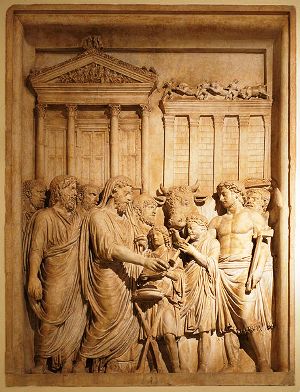
Religious sacrifice of a bull.
Bas-Relief. 2c AD. Capitoline Museum, Rome.
Courtesy: Wikipedia Commons.
This bull will be sacrificed by the Emperor
himself, Marcus Aurelius.
The piper plays to silence the audience.
The
fierce-looking guy leading the bull is a priest, and the boy in the
middle is offering the ritual incense box to the Emperor.
The Temple of Jupiter
Greatest and Best is in the background.
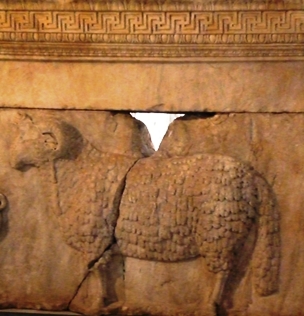
Sheep used in animal sacrifice.
Marble frieze known as the Plutei of Trajan. Roman. Curia, Roman
Forum, Rome.
|
|
|
|
|
|
|
|
|
|
|
|
|
Where did the Romans worship?
Religion was overwhelmingly a public affair, not a
private moment with one's Almighty.
A Roman could not turn around without running into, or smelling, a
sacred space.
Plowing the fields, walking to the market, at a crossroads
in the middle of nowhere, at one of the baths in the city, in your home,
carrying out public and administrative business, festivals and triumphs:
no escape from a god, sprite, or genius.
Who built
all these temples? The Roman social elite, not the state, was expected
to build them--no wonder there were so many.
The elite tossed up temples to celebrate
military victory, or in honor of a family member, or just
because they could financially. A triumphant general produced grand
temples with his own funds, or rather from the booty gained from
his military campaign.
A Roman city's main temple was often the first visible building in a city, gleaming
on top of an acropolis. One was always "looking up" to the
gods.
In Rome, the Temple of Jupiter Best and
Greatest, by far larger than the Parthenon, sat on top of the Capitoline
Hill. It could be seen for miles. What little of it exists
today is located inside the Capitoline Museum itself.
Other temples of normal-enormous size clustered in the center of a
city. Temples
towered over the humans, and not by accident.
Temples were designed to inspire awe for the state as well as respect
for the gods. All over Rome, I saw remnants of those huge temples--not
only those in the Forum, otherwise surrounded by rubble, but those still
in use like Hadrian's temple, pictured right.
Temples were built, rebuilt, redesigned,
enlarged, and rebuilt,
again and again as Rome prospered. Once Etruscan, Roman temple
architecture became increasingly Greek. The materials became exotic, the
architectural detail elaborate, as Emperors thrust emblems
of their magnificence and authority in the public's face.
Once back at home, you would worship
your own household gods,
the household genius, a household Vesta, and the spirits of your dead
ancestors.
|
|

Temple of Jupiter Best and Greatest (reconstruction). Era of Vespasian,
1st c AD.
Rome was extremeley crowded, temple after temple,
building on top of building.
The Temple of Jupiter lasted 900
years and then was destroyed by invasions, Christian recycling, and
time.

Temple of Hadrian
.
Rome; currently the Rome Stock
Exchange.
The columns tower over 48 feet in the air, with another 16 feet below
the current pavement level.

Temple of Vespasian
(ruins).
Roman Forum. Rome.
The height of Temple's columns measure about 8 times that of a
present-day Western, adult male. (Our mere mortal is standing on a high
viewing platform.) |
|
|
|
|
|
|
|
|
|
|
|
|
Humans into gods
The Emperor Vespasian, as he was expiring, declared,
"Oh, I think I am becoming a god."
But most Romans thought "no god arises from man."
Julius Caesar, who thought he was descended from Venus, upset this
stricture. He had politically powerful
friends who declared him "divine."
First Julius Caesar. Next, his successor Augustus,
whose wife Livia rewarded a senator with an outrageous fortune for
stating he saw Augustus ascend to heaven. After that, divinity for any
Emperor was almost a done-deal.
The slippery slope eventually included non-rulers: a wife or other
female relative of an Emperor was often declared divine, "suggested" by the
Emperor and declared so by the Senate.
Later Emperors did not make much effort to wait until death before
assuming the trappings of their upcoming divineness. The
probably-disturbed, and most certainly brutal and lazy, Emperor Commodus
converted the great Colossus statue of Nero, over 100 feet tall, into a
statue of himself as Hercules.
|
|
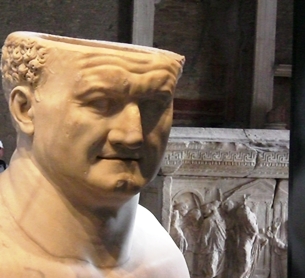
Emperor Vespasian.
Colossal head. Marble. Roman.
Displayed
at the Curia, the Roman Forum, Rome.

Visitors at Exhibit of Emperor-Gods,
including Vespasian and Titus.
Curia, Roman Forum, Rome. |
|
|
|
|
|
|
|
|
|
|
|
|
|
Glossary of Roman Religion |
|
|
|
|
|
|
Augurs:
Augurs
sought revelations and "advice" from the gods about the immediate
future. Through "taking of the auspices," the augurs established the
will of the gods about actions the Romans wanted to take. For example,
should a Roman general engage in battle with the enemy on a particular
day.
What an augur did: augurs observed
natural phenomena. The flight and activity of birds, thunder and
lightning, and feeding patterns of the sacred chickens held special
status.
The augur had to
follow
written instruction from his manual. The manuals contained the proper
techniques for the ritual and how to interpret the results. Signs given
by the gods to the augur were good only
for one day.
Duoviri, decemviri, and quindecimiviri:
a group of distinguished Senator-priests who
advised the Senate on reports of prodigies. Prodigies were events which the Romans
considered "unnatural," such as "rains of blood" or "monstrous
births."
Epulones:
specialized priests in charge of the
rituals of the Roman games and of the feast of Jupiter, Rome's most
important god. Along with the
pontifices, the augurs, and the duoviri, the epulones made up the four major
'colleges' of priests.
Fetiales:
Priests who prayed to the gods for success in war.
Flamines: a special group of
pontifices. Originally flamines were individual priests for the Roman gods
Jupiter, Mars, and Quirinus. As a distinguishing mark, the flamines wore a cap
with a piece of olive wood projecting from its top.
Haruspex:
A highly specialized
prophet, commonly Etruscan. Prophets tended to communicate with the gods
about more distant events in the future. The haruspex did his magic by inspecting the
liver of the sacrificed animal, normally a sheep. After the slave who
had killed the sheep handed its liver to the haruspex, the prophet held it in his
left hand, with his left foot on a stone and his right foot on the
ground , and "read" the liver in a clockwise direction. Haruspices could also be personal advisors--Julius Caesar had one.
Luperci:
these priests ran the Festival of the Lupercalia, when
near-naked young men ran around the City, striking the young women they
met with a goat thong. A fertility rite? A purification ritual?
Ordinary priests:
Their job was
to lead the sacrificial process, initiate the sacrifice, and watch.
Evidently, they weren't expected to know what to do, even the right
form of prayer to offer. Their real role was to represent their
aristocratic class, to show the Roman people that the
aristocratic oligarchy was at the top of the social, political,
and religious orders.
Pontifex, pontifices: Their original function was to
look after Rome's first bridge across the Tiber, the City's most
critical crossing point. From there, the pontifices assumed oversight over
other major "crossing
points," for example those between life and death, or communications between the humans
and the gods.
One of the pontifices' most important authority was control of the calendar,
which determined many aspects of Roman life. They could be powerful
decision-makers, especially in moments of crisis. Less dramatically, they kept the annual record of public events
and gave legal advice on family matters, such as
wills, inheritances, family property, adoptions, and burials.
Prodigy: An event which the
Romans considered "unnatural," such as "rains of blood" or
"monstrous births." Would-be prodigies had to be reported to the Senate for
evaluation and consultation with the priests.
Vestal Virgins: The only female priesthood in Rome, its
six members were chosen in childhood. They lived in a special house next
to the temple of Vesta in the Roman Forum and could ride in a wagon. Their various
rituals connected the fertility of the earth, the safety of the flocks
of animals, and human fertility. They were the guardians of ancient,
ancient talismans, including it was said, sacred objects brought by
Aeneas from Troy.
With special privileges went special responsibilities: if a Virgin let the sacred
fire go out, or was unchaste, she could be buried alive.
|
|
|
|
|
|
Web Resources and Books |
|
|
|
|
|
|
General interest
www.wikipedia.com
www.seindal.dk
www.dmoz.org
www.flickr.com
www.sacred-destinations.com
www.unrv.com
Specialized or advanced
http://penelope.uchicago.edu/Thayer/E/Gazetteer/
Periods/Roman/home.html
www.livius.org
http://oyc.yale.edu/history-art
|
|
|
|
|
|
|
|
Books |
|
|
|
|
|
|
Beard, Mary, et. al,
Religions of Rome (Cambridge Univ. Press, 1998) 2
vols.
Boatwright,Mary,
Hadrian and the City of Rome
(Princeton UP, 1987)
Fox, Robin Lane,
Pagans and Christians (Knopf, 1986)
Potter, David S., "Roman Religion: Ideas and Actions," in Potter, D.S.
and Mattingly, D.J., Life, Death, and Entertainment in the
Roman Empire
(U of Michigan Press,
1999).
Price, Simon,
The Birth of Classical Europe: A History from Troy
to Augustine (Penguin, 2011)
Stamper, John,
The Architecture of Roman Temples: the Republic
to the Middle Empire
(Cambridge U. Press, 2004)
Biographies of the various rulers of Rome, such as Anthony Barrett, ed.,
Lives of the Caesars (Blackwell, 2008)
|
|
|
|
You may contact me, Nancy Padgett, at
NJPadgett@gmail.com |
|
|
|
|